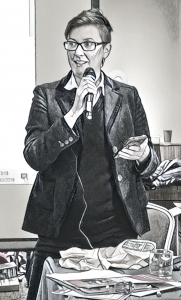
This article is the second part of a two part series.
It started out as a plan for a collection of resources with a brief introduction but the brief introduction took on a life of its own, rather like one of my mum’s enthusiastic runner bean plants, and morphed into Part 1.
Part 1 is designed to be read first, and you can do that here.

Welcome to Part 2.
When my daughter identified as a boy, back in 2015, there were very few questioning and critical resources available online for parents whose kids thought they’d been born the wrong sex.
Now, putting this article together, I’m struck by how much more attention the subject has gained in the media this last couple of years. There are hundreds of articles, videos and podcasts out there, questioning the current trans narrative and the ethics of imposing it on children.
 I call this article ‘So your child thinks they might be transgender’, although generally kids who think they’re transgender don’t think they ‘might’ be: they absolutely, definitely KNOW they are – until, often, they don’t and they aren’t.
I call this article ‘So your child thinks they might be transgender’, although generally kids who think they’re transgender don’t think they ‘might’ be: they absolutely, definitely KNOW they are – until, often, they don’t and they aren’t.
Fewer and fewer kids are being given the time to think about this as we rush in with the untested but fashionable affirmation model, assuring them that it’s quite possible to be ‘born in the wrong body’ and that it’s quite possible to change sex. I discuss this dubious approach in more detail in part 1 of this article.
This second part concerns itself with sharing resources that may be of especial interest to the parents of trans-identified children and young people.
Many of the writers, speakers or organisations that I mention below have come under attack from transactivists who support the transitioning of children. Some accuse them of being funded by the far right and/or of hating trans or ‘LGBTQ+’ people. These accusations are disingenuous, untrue and unconvincing.
I have not linked to the work of any individual, group or organisation promoting hate, bigotry or intolerance. It should go without saying that the fact that I list an article or video here doesn’t mean that I necessarily agree with everything said therein, or share every opinion of the content creators.
 I’ve tried to be diverse in my selections, so you’ll come across everything from newspaper articles to peer reviewed studies; the views of young people who thought they were trans but changed their minds (desisters) and those who started down a medical transition pathway and then stopped (detransiitoners), taking in the writings of feminists and parents; psychiatrists, clinicians, doctors and academics along the way. The links here are far from exhaustive – I had to stop somewhere! – but many have links branching out to other thoughtful and informative pieces.
I’ve tried to be diverse in my selections, so you’ll come across everything from newspaper articles to peer reviewed studies; the views of young people who thought they were trans but changed their minds (desisters) and those who started down a medical transition pathway and then stopped (detransiitoners), taking in the writings of feminists and parents; psychiatrists, clinicians, doctors and academics along the way. The links here are far from exhaustive – I had to stop somewhere! – but many have links branching out to other thoughtful and informative pieces.
ORGANISATIONS
Transgender Trend
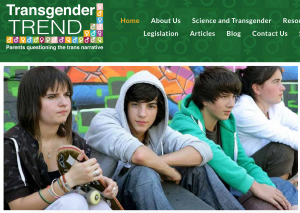 An excellent starting place for parents wanting to know more from a reliable and established source is Transgender Trend. The TGT website has a wealth of articles on the subject of children, gender identity, safeguarding and inclusivity.
An excellent starting place for parents wanting to know more from a reliable and established source is Transgender Trend. The TGT website has a wealth of articles on the subject of children, gender identity, safeguarding and inclusivity.
Transgender Trend was started by a group of UK parents who question the current trans narrative. It has been established for many years and has no political or religious affiliation.
“We don’t have any evidence that children really are trans, this is a very new phenomenon which is based on no credible scientific research. Children’s preference for particular toys and activities just reflects their personalities and we need to take care not to read any deeper meaning into their choices, but allow children to explore and form their own identities at their own pace… We do believe in listening to children, we think it’s really important. But listening doesn’t mean always agreeing with a child. Children know who they are as children, they can’t know how they will change, in fact the belief that you will never change is a symptom of childhood and adolescence.”
 Transgender Trend has produced a schools resource pack, in consultation with teachers, child protection and welfare professionals and lawyers. It can be downloaded free, or you can ask for a hard copy to be sent to you for your child’s school. A template for an accompanying letter is also available at the above link.
Transgender Trend has produced a schools resource pack, in consultation with teachers, child protection and welfare professionals and lawyers. It can be downloaded free, or you can ask for a hard copy to be sent to you for your child’s school. A template for an accompanying letter is also available at the above link.
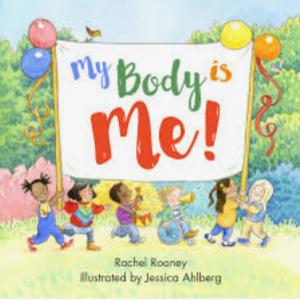
Transgender Trend has recently worked with writer and Primary and SE teacher Rachel Rooney and illustrator Jessica Ahlberg to produce ‘My Body is Me’, an adorable, high-quality, picture book for 3-6 year olds.
The book can be purchased here for just £5, with a free lesson plan for teachers.
The Transgender Trend website also has extensive information about puberty blockers, sex hormones and social transition.
4thWaveNow
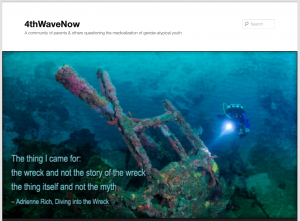 4thWaveNow is an American website, a ‘community of parents & others questioning the medicalization of gender-atypical youth’.
4thWaveNow is an American website, a ‘community of parents & others questioning the medicalization of gender-atypical youth’.
What Transgender Trend is to the UK, 4thWaveNow is to the USA. Although the groups are very different, both are reasoned, reliable and a treasure trove of articles, facts and information on gender and trans issues in relation to children and young people.
Like Transgender Trend, 4thWaveNow has been established for many years and is an organisation with no political or religious affiliation.
4thWaveNow was started by a mother whose daughter announced she was transgender ‘after a few weeks of total immersion in YouTube transition vlogs and other trans-oriented social media’. Her daughter has since desisted.
Struck by the lack of information and resources available to parents who questioned the ‘born in the wrong body’ narrative, this mother began writing about her own experiences and views. The website has grown into a platform featuring not only her writing but that of ‘other parents, formerly trans-identified people, and people with professional expertise and experience with young people questioning their gender identity’.
4thWaveNow is where mine and my daughter’s story was first published, here, in December 2016.
The Gender Critical Support Board

The Gender Critical Support Board was established in 2017. It has nearly 2000 members and is run for parents and families by parents and families who share the experience of coping with a child, teenager or young adult who believes she or he is transgender.
While most of the content is only visible to members of the board, always beware of giving out identifiable personal details on any online forum and be aware that people may not be who they say they are.
Safe Schools Alliance
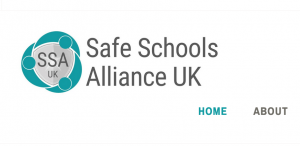 Safe Schools Alliance is concerned that schools are being ‘trained’ by trans lobby groups and advised to use policies regarding gender identity that are based on misleading or inaccurate information. It encourages schools to review these policies.
Safe Schools Alliance is concerned that schools are being ‘trained’ by trans lobby groups and advised to use policies regarding gender identity that are based on misleading or inaccurate information. It encourages schools to review these policies.
“Safe Schools Alliance is a group of concerned parents, grandparents, teachers, governors, health professionals, education professionals, and carers from more than 30 local education authority areas in the UK. We are from a wide range of backgrounds and have no religious or political affiliation.”
Parents of ROGD kids
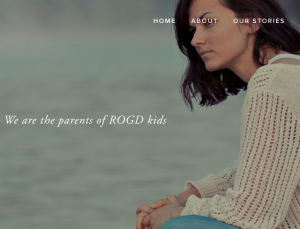 This group was started by ‘parents whose children have suddenly—seemingly out of the blue—decided they identify strongly with the opposite sex and are at various stages in transitioning.‘ They are skeptical of the ‘affirmative approach’ which they believe ‘only seems to confirm and solidify our children’s misguided, externally-influenced sense of self’. Their resources include guidelines for finding a trustworthy therapist for your child and co-ordinating support groups for parents.
This group was started by ‘parents whose children have suddenly—seemingly out of the blue—decided they identify strongly with the opposite sex and are at various stages in transitioning.‘ They are skeptical of the ‘affirmative approach’ which they believe ‘only seems to confirm and solidify our children’s misguided, externally-influenced sense of self’. Their resources include guidelines for finding a trustworthy therapist for your child and co-ordinating support groups for parents.
Gender Health Query
 GHQ are a group of LGBT people and allies who want to protect all gender nonconforming youth- with or without gender dysphoria. Objectives are to ‘prevent the over-medicalisation of gender nonconforming youth, prevent harm resulting from medical treatments on trans-identified minors and to address confusion and rights conflicts that arise from new ideologies about gender’.
GHQ are a group of LGBT people and allies who want to protect all gender nonconforming youth- with or without gender dysphoria. Objectives are to ‘prevent the over-medicalisation of gender nonconforming youth, prevent harm resulting from medical treatments on trans-identified minors and to address confusion and rights conflicts that arise from new ideologies about gender’.
Canadian Gender Report
 A group of ‘parents and professionals concerned about the medicalization of identity and the erosion of sex-based rights… and the lack of open discussion on issues that are affecting Canadian families and children.‘
A group of ‘parents and professionals concerned about the medicalization of identity and the erosion of sex-based rights… and the lack of open discussion on issues that are affecting Canadian families and children.‘
Our Duty
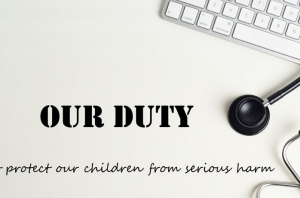 The recently established ‘Our Duty’ Facebook page collects articles, videos and stories concerning trans-identified young people and desisiters.
The recently established ‘Our Duty’ Facebook page collects articles, videos and stories concerning trans-identified young people and desisiters.
“Our Duty as parents is to protect our children from serious harm. Our children are being harmed by those who tell them they can change sex. ”
Bayswater Support Group
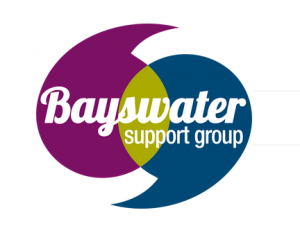 BSG are a group of parents in the UK and Ireland who have been ‘brought together by our experiences of parenting children with gender dysphoria or who have declared a transgender identity‘.
BSG are a group of parents in the UK and Ireland who have been ‘brought together by our experiences of parenting children with gender dysphoria or who have declared a transgender identity‘.
Their website offers resources and advice; they also have a support forum which parents of gender dysphoric children can register to join.
The LGB Alliance
 Many trans-identified children first come out as lesbian, gay or bisexual, and homophobia can often play a part in the change in perspective. The LGB Alliance stands up for ‘the right to live as same-sex attracted people without discrimination or disadvantage’.
Many trans-identified children first come out as lesbian, gay or bisexual, and homophobia can often play a part in the change in perspective. The LGB Alliance stands up for ‘the right to live as same-sex attracted people without discrimination or disadvantage’.
“The numbers of children, particularly girls, seeking help has increased at an alarming rate. We believe that this is related to the rise of pseudoscience and increased misinformation about basic biology along with a rise in homophobia and anti-lesbian sentiment and lesbian invisibility.”
Organisations concerned with the effect of trans ideology on women’s rights as well as the rights of children include:
Fair Play for Women campaign for the rights of women and girls in sports.
Hands Across the Aisle is an alliance of radical feminists, lesbians, Christians & conservatives committed to working together to oppose gender identity ideology.
Other groups that may be of interest are Standing for Women, Resisters United, OBJECT, and The Lesbian Rights Alliance
 From peer-reviewed scientific research to mainstream newspaper articles; taking in thoughts from parents, psychologists, academics, doctors, feminists, journalists and young people themselves along the way.
From peer-reviewed scientific research to mainstream newspaper articles; taking in thoughts from parents, psychologists, academics, doctors, feminists, journalists and young people themselves along the way.
After a few failed attempts to specifically categorise these writings, I decided to list them by date.
2015
Sex & Gender – A Beginner’s Guide – Rebecca Reilly-Cooper – 2015
“The oppression linked to sex begins at birth, operating through the social imposition of gender… the value system that prescribes and proscribes forms of behaviour and appearance for members of the different sex classes.” Whilst not dealing specifically with its influence on children and young people, Reilly-Cooper’s excellent analysis of gender is a good place to start.
Parents, keep listening to your gut—not the gender therapist – 4thWaveNow – December 2015
The mother of a desister writes:“Without even meeting my child in the flesh, all four (gender) therapists talked to me like this trans thing was a done deal… Until the last few years, parents who recognized that teens go through phases weren’t considered abusive. They were considered well informed… Given my own daughter’s desistence from the idea that she is or was ever ‘transgender’, I feel even more strongly that parents are right to resist the push by every sector of society to identify gender dysphoric minors as ‘trans’.”
Comment | The Transgender Experiment on Kids – Stephanie Davies-Arai – October 2015
Davies-Arai says that a generation of kids is being used as guinea pigs: “the theory that children have an innate ‘gender identity’ which does not match their biological sex has no scientific basis; it is impossible to have a brain which is the opposite sex of the body.”
2016
Do Trans Kids stay Trans When they Grow Up? – James Cantor, Sexology Today – January 2016
Cantor recounts, “There have been three large scale follow-up studies and a handful of smaller ones… all the studies have come to a remarkably similar conclusion: only very few trans kids still want to transition by the time they are adults.”
Child gender identity referrals show huge rise in six years – BBC News – February 2016
Callum McKenzie reports on the marked increase in children referred to the NHS with gender identity issues. With graphs showing figures from the Tavistock.
How the Fight Over Transgender Kids Got a Leading Sex Researcher Fired – Jesse Singal – February 2016
Singal looks at the story of Dr Kenneth Zucker, who led the Child Youth and Family Gender Identity Clinic (GIC), in Toronto before being unceremoniously fired for his resistance to the ‘gender affirmative’ approach.
Gender is not a Spectrum – Rebecca Reilly-Cooper – June 2016
“..there seems to be an immediate tension between the claim that gender is not a binary but a spectrum, and the claim that only a small proportion of individuals can be described as having a non-binary gender identity”. One of my first ‘peak trans’ moments was coming across Rebecca Reilly-Cooper’s article dealing with the ‘illogical and politically troubling‘ issues surrounding the idea of being non-binary.
What’s Missing From the Conversation About Transgender Kids – Jesse Singal – July 2016
Journalist Singal discusses a subject that ‘can get extremely heated and tricky‘: addressing how homosexuality, trauma and psychological issues can affect a young person’s gender identity.
Hippocrates Rolls in his Grave: in search of the dysphoric trans-teens of yore – 4thWaveNow – August 2016
“So, if transgender children have existed since the dawn of humanity, and if the only cure for intense childhood gender dysphoria is medical transition, then there can be no doubt that there would be historical records of such miserable transgender children. Right?” Yet it seems not.
Why do Teenage Girls not Want to Become Women? – Transgender Trend – October 2016
If we accept that the only reason a girl says “I’m a boy” is because she really is one, it absolves us of any responsibility to examine that statement within the wider context of a girl’s life experiences and influences. It means we’re not obliged to look at the culture within which our girls are growing up in the UK; we can assume that girls are happily immune to any harmful cultural messages and experiences. We need not ask the question “Why do so many teenage girls not want to become women?”
A Scientist Reviews Transgender Suicide Stats – Transgender Trend – December 2016
How much truth is behind the oft quoted statistic that almost half of trans-identified young people attempt suicide? Analysis of the study quoted shows that only 27 of the young people were trans-identified- not over 2,000 as was claimed by Mermaids. Other issues are also raised. ‘Presenting this trope to families of transgender children and young people is nothing short of emotional blackmail.’
2017
Transgender Kids: why doctors are right to be cautious about childhood transition – Sarah Dittum – January 2017
Sarah Dittum discusses the work of Ken Zucker, the silencing of doctors and what it means to call a child ‘trans’.
‘They Were Transgender Until they Weren’t’ Katie Herzog – June 2017
Herzog interviews several young people who detransitioned, as well as some who didn’t.
Everything You Believe Is Wrong: There Is No Such Thing As A Male Or Female Brain – Cristia Spears Brown – July 2017
Brown addresses ‘why the myth of pink brains and blue brains sticks so firmly in our collective consciousness,’ when even neuroscientists can’t tell if an individual brain belongs to a man or woman.
Suicide or transition: The only options for gender dysphoric kids? Drs Bailey & Blanchard – September 2017
First in a series of two: psychologists Blanchard & Bailey discuss problems with the current mainstream narrative regarding gender dysphoria.
What about the children who said they were transgender & then changed their minds? – Jo Bartosh – September 2017
Mum Penny White talks to Bartosh about her 12-year-old daughter who “diagnosed herself with gender dysphoria” and explains her concerns about the approach taken by organisations such as Mermaids and GIRES.
Outbreak: On Transgender Teens and Psychic Epidemics – Lisa Marchiano – October 2017
“Currently, we appear to be experiencing a significant psychic epidemic that is manifesting as children and young people coming to believe that they are the opposite sex, and in some cases taking drastic measures to change their bodies.” Jungian psychologist Marchiano discusses this in the journal ‘Psychological Perspectives‘.
Meet Alex Bertie, the transgender poster boy – Janice Turner – November 2017
Janice Turner investigates the rise in girls wanting to be boys and meets trans icon Alex Bertie. Behind a Times paywall (you can register to read 2 articles free each week and this one is well worth the effort) she also talks to my daughter Jessie and others.
Gender Dysphoria is not One Thing Drs Bailey & Blanchard – Dec 2017
Second in a series of two: psychologists Blanchard & Bailey discuss different types of dysphoria and how ‘the best scientific evidence suggests that gender transition is not necessary to prevent suicide’.
2018
Gender Dysphoria & Children: An Endocrinologist’s Evaluation of ‘I am Jazz’ – Michael Laidlaw – April 2018
Endocrinologist Laidlaw looks at popular children’s book ‘I am Jazz’, suggesting it ‘contains both false information and very troubling omissions. Children who are experiencing gender dysphoria will likely be harmed by this book, as will children who do not have the condition’.
When Children Say They’re Trans – Jesse Singal – Aug 2018
Claire is a 14 year old girl from Philadelphia, where she lives with her parents. Despite using awkward language like ‘assigned sex’, this article tells the story of a Claire’s sudden trans-identification and desistance.
‘Parent reports of adolescents and young adults perceived to show signs of a rapid onset of gender dysphoria‘. Lisa Littman – August 2018
Littman’s peer-reviewed academic study was met with anger by much of the transgender community who accused both Littman and the parents who took part of ignorance, transphobia and bigotry.
ROGD: A Detransitioner Speaks – Helena – November 2018
Helena is a young woman who is a detransioner; a young woman who got a prescription for testosterone after a single appointment. She joins the ever-growing ranks of desisters and detransitioners and agreed to write this piece as a guest post for my blog.
Pseudo-Scientific Hokum And The Experimentation On Children’s Bodies – Julian Vigo – December 2018
Vigo reflects on her communications with trans lobby group Mermaids and explores what kind of support the group really offers ‘gender non-conforming’ kids and their families.
2019
‘Taking the lid off the box’: The value of extended clinical assessment for adolescents presenting with gender identity difficulties – Anna Clarke – February 2019
Academic article: summary of 12 adolescents who resolved or diminished their gender dysphoria with counseling. Discusses adolescent gender identity.
Meet the neuroscientist shattering the myth of the gendered brain – Genevieve Fox – February 2019
Beliefs about sex differences inform stereotypes… which, in turn, historically carry with them huge amounts of ‘contents assured’ information and save us having to judge each individual on their own merits or idiosyncrasies.
The Tavistock’s Experiment with Puberty Blockers – Michael Biggs – July 2019
Biggs calls for the impartial investigation and publication of statistics from the Tavistock study on the provision of NHS prescribed puberty blocking drugs to children.
Posie Parker’s Graphic Protest against Stonewall Policies – Jo Bartosh – July 2019
Bartosh reports on the protest made by Parker and others at the Stonewall ‘Children and Young People Conference 2019’. Banners featured graphic images of the results of so-called ‘gender affirming’ surgeries and the wording ‘‘Transing children is child abuse. Are you part of it?’
Puberty blocking drugs: ‘For the past four years I’ve been stuck as a child’ – Lucy Bannerman The Telegraph – July 2019
(behind a paywall but you can register for 2 free articles a week)
‘Jacob’ claims side effects of taking puberty blockers included insomnia, exhaustion, low moods & rapid weight gain. After stopping, Jacob (who still identifies as male) says “I grew taller, I lost weight, I felt livelier. It was like getting the poison out of my system.”
No-one is Born in the Wrong Body – Malone, Wright & Robertson – September 2019
“…instead of offering counselling, medical professionals now are commonly telling children that they may have been “born in the wrong body.” This new approach, called “gender affirmation,” makes gender dysphoria less likely to resolve”. Detailed and thoughtful piece from an endocrynologist, an evolutionary biologist and a journalist.
Autistic Girls – Gender’s Silent Frontier – Jane Galloway – September 2019
Jane Galloway is an Autistic woman with ADHD. She is a passionate advocate for autistic women and girls. Here she writes of her own experience and gives her view on the reasons behind the exponential rise in the number of autistic girls being referred to Tavistock GIDS.
Transgender lobby group Mermaids urges puberty‑blockers for 12‑year‑olds – Sunday Times – September 2019
(behind a paywall but you can register for 2 free articles a week)
The advice given to school teachers in a Mermaids training session was attacked as “misleading and potentially dangerous” by an Oxford academic. The session is believed to be a blueprint for training by the group in schools nationally.
A physician is worried about gender transition in pediatrics – Julia Mason – October 2019
A doctor writes, “I’ve learned that if I refer a patient to the gender clinic, they are going to get the maximalist treatment. They’re not going to get any help figuring out if they really need the full medical/surgical transition. I am now wary of referring to the gender clinic.”
‘Transgender Children – a discussion’ – Toby Young & Stephanie Davies-Arai – November 2019
Stephanie Davies-Arai’s essay (quoted above) ‘Is ‘affirmation’ an appropriate approach to childhood gender dysphoria?’ These two essays for CIVITAS, the other by Toby Young: ‘Why are so many schoolchildren coming out as trans?‘ can be either read or downloaded here.
Meet the ‘detransitioners’: the women who became men and now want to go back – Joani Walsh – November 2019
Walsh talks in the Telegraph to Charlie Evans and Keira about how young women are ‘sold this idea that transitioning was magically going to solve their problems’ and how
The Hard Questions About Young People and Gender Transitions – Andrew Sullivan – November 2019
Sullivan meets some desisters who ‘worry that any kind of therapy apart from affirmation of transgender identity is now seen as transphobic, and that teens are able to get hormones far too easily‘.
Here are links to my own articles concerning child transition, its harms and its facilitators:
![]()
Bind Me:“I’m feeling ecstatic and scared & mum’s feeling sick” October 2017
When is a girl not a girl? November 2017
What makes somebody ‘real trans’ part 2: Kids’ January 2018
But nobody is encouraging kids to be trans! March 2018
ROGD July 2018
Child transition – the myth of informed consent – August 2018
The Gendered Child April 2019
Kool-Aid for kiddies – teaching little ones about the gender fairy – June 2019
GenderCare – Dr Lorimer brings all the transboys to the yard – August 2019
Inventing the Transgender Child – a conference – October 2019

Sometimes you can’t take the time to sit down to read an article or watch a video. Here are some podcasts for anytime listening.
‘The Trouble with Transing Kids‘ – Meghan Murphy & Lisa Marchiano
This podcast from Feminist Current asks, ‘are we moving too quickly? What are the consequences of medical interventions like this on children? What are the social consequences?’ Meghan Murphy talks to social worker and analyst Lisa Marchiano.
Gender Dysphoria 101 – Debra Soh & Susan Bradley
Debra speaks with Dr. Susan Bradley, a world-renowned expert on gender dysphoria. In this podcast they discuss the link between gender dysphoria & sexual orientation, the incidence of psychiatric co-morbidity- including autism and depression – in girls presenting with ROGD. They also discuss the dismissal and work of Ken Zücker.
Therapy & the Teen Gender Crisis – Benjamin Boyce with Sasha Ayad
Sasha Ayad is a Licensed Professional Counselor who works with adolescents on issues around gender identity. She’s been an outspoken critic of the affirmation-only gender therapy model that is pushed by trans activists. Her therapeutic approach is exploration-based, compassionate, and seeks out a more nuanced understanding of the client as a whole person.
Parenting the Gender Dysphoric Child – Benjamin Boyce with Sasha Ayad
In this conversation (their second) they speak about her therapeutic approach, the developmental importance of identity, and how it can often be confused with individuality—that is, being an authentic self.
“It was his Rapid Onset Gender Dysphoria that broke me.” Secrets of the Motherworld
“My 17 year old, has undiagnosed high-functioning Autism, a high IQ, a history of school refusal, debilitating homesickness, anxiety and addictive behaviour but …” Stella O’Malley and Lisa Marchiano discuss this woman’s story.
Posie Parker and Venice Allan: adult, human females
Trans-sceptical feminists Posie Parker and Venice Allan talk with Brendan O’Neil, discussing the silencing of women, the dangers of transitioning children, and the Orwellianism of preferred pronouns.

There are lots of videos out there that will tell you that transitioning children is effective, even essential, and that transition is the best answer to a child or young person’s gender dysphoria. Videos that question gender ideology, address the harm that can be done, or the ineffectiveness of transition, are harder to find. Here are some of those videos and documentaries.
Gender for Dummies in 5 minutes – Peach Yoghurt – June 2015
One of Peach’s first videos, this does what it says on the tin: “All you need to know about gender in one short video”. Possibly one to watch with your child, it raises some basic questions and answers around gender roles and their relationship to our sexed bodies.
Transing a 5 year old Tomboy – Magdalen Berns – June 2016
With her trademark dry humour and wry cynicism, Berns looks at some of the inherently sexist reasons behind transitioning children, and the professionals and parents behind the social transition of a five year old girl.
Why I transitioned/detransitioned by FrankOMG – December 2016
23 year old man from Florida talks about what led him to transition and detransition.
Transgender Kids – Who knows best? BBC 2 Documentry – January 2017
Documentary exploring approaches parents can take if their child has childhood gender dysphoria. “The film presents evidence that most children with gender dysphoria eventually overcome the feelings without transitioning and questions the science behind the idea that a boy could somehow be born with a ‘female brain’ or vice versa.”
Who am I? – 60 minutes Australia documentary – September 2017
Patrick was diagnosed with gender dysphoria age 12. His mother supported and enabled his transition and provided him with hormones which caused him to develop breasts. She now says ‘they were wrong to pigeonhole him so quickly’ Age 14, Patrick changed his mind. This documentary tells his story.
Implications of self-ID for children and young people -Michele Moore – 2018
Michele Moore co-editor of ‘Transgender Children and Young People, Born in Your Own Body’ speaks at a Woman’s Place about the implications of affirming self-declaration of gender in children and young people and the influencers who are ‘fixing children in a one way street’. Essential viewing.
Posie above the Parapet with Stephanie Davies-Arai – May 2018
Posie has a chat with Stephanie Davies-Arai about her work in assisting gender questioning children and their families, her schools pack and activism.
Parents, don’t let them label your child transgender! – Peach Yoghurt – 2018
Peach turns her hand to addressing concerned parents, observing “I was such a child, but now I’m a healthy and happy lesbian.” What are the criteria for declaring a child transgender?
The Trans-Train & Teenage Girls – Karin Mattinson – May 2019
This Swedish documentary with English subtitles looks at the increase of teenage girls with gender dysphoria, the concerns of parents and health care staff and discusses the lack of research within this new group of patients. Can transition be a mistake? Two detransitioned females speak. The Swedish Lundstrom gender clinic provides trauma therapy for detransitioners.
The Trans-Train – Part Two – December 2019
Swedish politicians argue that fifteen-year-olds with gender dysphoria should be allowed to undergo gender reassignment surgery without consent from their parents or they are at risk of committing suicide. But is this really true? ‘Mission Investigate’ continues to investigate transgender health care and explore the arguments from politicians.
Transgender treatment: Puberty blockers study under investigation – BBC Newsnight – July 2019
England’s only NHS youth gender clinic lowered the age at which it offers children puberty blockers, partly based on a study now being investigated. The study’s full findings have not been published – but early data showed some taking the drugs reported an increase in thoughts of suicide and self-harm.
Trans Kids – it’s time to talk – Channel 4 documentary – December 2018
Stella O’Malley considers the huge rise in numbers of young people embarking on gender transition, through the prism of the gender identity issues that she experienced when she was a child.
Transgender Regret – Dutch documentary – December 2018
Subtitles added in 2019 by PeachYoghurt. This Dutch documentary deals with ‘the dark side’ of transition, regret, the one that is rarely lauded in the press.
Detransition Q&A #1 – Pique Resilience Project -February 2019
Four young women who have detransitioned or desisted answer some questions about detransition and their feelings around their own transition. The channel also features interviews with individual young women who have desisted or detransitioned.
Hundreds of young people seeking help to ‘return to original sex’ – Sky News item – October 2019
Charlie Evans, who detransitioned in 2018, speaks to Sky News about young people who have undergone gender reassignment surgery but wish they hadn’t.
Why I detransitioned, and why I’m talking about it now – Laura Reynolds – December 2019
Reynolds talks about her own transition and detransition and her feelings about transitioning children.
NHS ‘over-diagnosing’ children having transgender treatment, former staff warn‘- Sky News – December 2019
Sally Lockwood and Helena Lambert look into claims that children treated for gender dysphoria are ‘over-medicalised’ as psychologists fear being branded transphobic. They look at the ever-increasing number of transitioning girls and the ease with which they can access medical transition if they can bypass the NHS waiting lists. With accompanying text.
Vulnerable Child Protection Act 2020 – M Laidlaw MD – January 2020
Endocrynologist Michael Laidlaw’s clear, calm and informed testimony for the Vulnerable Child Protection Act of South Dakota, presented to the House State Affairs Committee of the Great State of South Dakota, explains the harms that are being done to vulnerable children from a medical perspective.
P.S.

I started writing this article several months ago. Where to stop? Whereas there were some pieces I knew I had to include right from the start, others I came across as I went along. Of course, I had to read, listen to or watch every piece before deciding whether to include it or not, so the process certainly was an education. I plan to continue to add to this occasionally, as exceptional new pieces surface.
Parents, you are not alone; I truly believe the tide is turning.

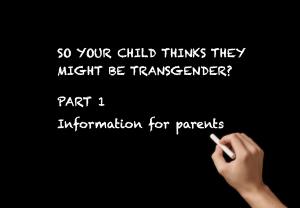
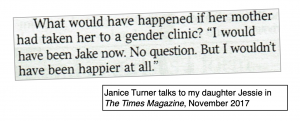

 There are important questions to be asked and discussions to be had, concerning both child autonomy and child safeguarding, and the current political climate does not support this debate.
There are important questions to be asked and discussions to be had, concerning both child autonomy and child safeguarding, and the current political climate does not support this debate.
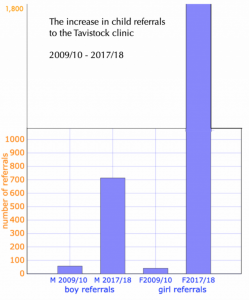 More young people than ever are identifying as transgender. This graph, which covers the last ten years, is based on the Tavistock GIDS own figures. You can check them yourself.
More young people than ever are identifying as transgender. This graph, which covers the last ten years, is based on the Tavistock GIDS own figures. You can check them yourself. 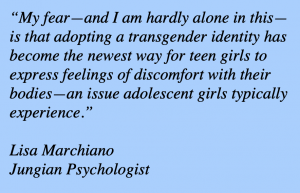 Despite many young people, and even more parents, having reported experience of ROGD, most groups established to help transgender young people staunchly refuse to acknowledge its existence, insisting that if a child says they are trans then they are trans, and that a refusal to accept this is harmful and abusive.
Despite many young people, and even more parents, having reported experience of ROGD, most groups established to help transgender young people staunchly refuse to acknowledge its existence, insisting that if a child says they are trans then they are trans, and that a refusal to accept this is harmful and abusive.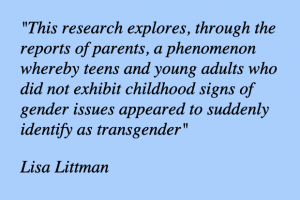 Academic Lisa Littman, Assistant Professor of the Practice at the Brown University School of Public Health, carried out
Academic Lisa Littman, Assistant Professor of the Practice at the Brown University School of Public Health, carried out 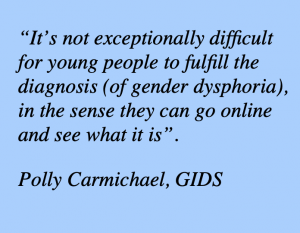
 When I typed ‘how many genders’ into Google, the top hit of the six hundred and thirty one million that it threw up in less than a second told me this:
When I typed ‘how many genders’ into Google, the top hit of the six hundred and thirty one million that it threw up in less than a second told me this: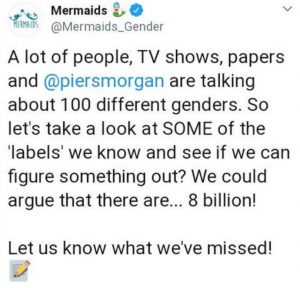
 Even the government’s own Office for National Statistics (ONS) is playing the gender game. It has
Even the government’s own Office for National Statistics (ONS) is playing the gender game. It has 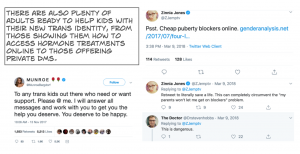
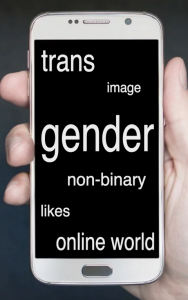
 Child suicides are thankfully incredibly rare. The idea that trans-identified children will kill themselves if not transitioned is irresponsibly promoted on television, on websites, in interviews and perpetuated by the media and transgender ‘support’ groups. It is almost as if the idea of suicide ideation is marketed to confused and unhappy children as a bargaining and silencing tool and an essential facet of a trans-identity. Such reporting contravenes Samaritans guidelines, whose r
Child suicides are thankfully incredibly rare. The idea that trans-identified children will kill themselves if not transitioned is irresponsibly promoted on television, on websites, in interviews and perpetuated by the media and transgender ‘support’ groups. It is almost as if the idea of suicide ideation is marketed to confused and unhappy children as a bargaining and silencing tool and an essential facet of a trans-identity. Such reporting contravenes Samaritans guidelines, whose r There have been nearly a dozen
There have been nearly a dozen 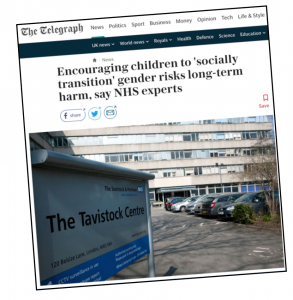 “For some families the social transition can work as a kind of ‘it’s all going to be fine’ and actually the system is way more complicated than that.”
“For some families the social transition can work as a kind of ‘it’s all going to be fine’ and actually the system is way more complicated than that.”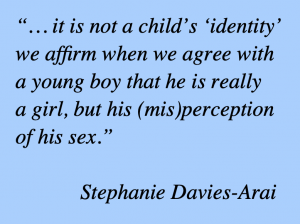 “Unquestioning affirmation of a child’s belief is not a neutral act of kindness, but an active intervention that shapes and changes a child’s understanding and development. Affirmation by trusted adults forms or reinforces a child’s perception of reality. Living, and being affirmed daily as the opposite sex will affect and change the child’s developing sense of self, which risks creating a self-fulfilling prophesy.”
“Unquestioning affirmation of a child’s belief is not a neutral act of kindness, but an active intervention that shapes and changes a child’s understanding and development. Affirmation by trusted adults forms or reinforces a child’s perception of reality. Living, and being affirmed daily as the opposite sex will affect and change the child’s developing sense of self, which risks creating a self-fulfilling prophesy.” If you aren’t letting your child cut/grow their hair and dress (within reason) in clothes they choose themselves, ask yourself why not? If you’re forcing your daughter to do ballet, or your son to play football, encouraging a girl with no interest in performing femininity to “make herself pretty” or berating a sensitive boy to “man up”, this may be part of the problem. Gender roles are everywhere and often we don’t even consciously notice them. While many people slip fairly happily into the behaviours and clothing choices society expects from them, many don’t. And that’s just fine. There are plenty of happy, successful and super-cool people who don’t ‘perform masculinity or femininity’. Sometimes, but not always, they’re gay.
If you aren’t letting your child cut/grow their hair and dress (within reason) in clothes they choose themselves, ask yourself why not? If you’re forcing your daughter to do ballet, or your son to play football, encouraging a girl with no interest in performing femininity to “make herself pretty” or berating a sensitive boy to “man up”, this may be part of the problem. Gender roles are everywhere and often we don’t even consciously notice them. While many people slip fairly happily into the behaviours and clothing choices society expects from them, many don’t. And that’s just fine. There are plenty of happy, successful and super-cool people who don’t ‘perform masculinity or femininity’. Sometimes, but not always, they’re gay. While some trans advocacy groups accuse parents who don’t affirm their child’s transition of conversion therapy, many of us see the opposite as true. People who feel their gods may have a problem with homosexuality, or who feel uncomfortable with it themselves, may feel more comfortable with a ‘born in the wrong body’ narrative. Converting your gay child into a straight trans child may seem a viable option, especially if the idea is instigated by the child itself.
While some trans advocacy groups accuse parents who don’t affirm their child’s transition of conversion therapy, many of us see the opposite as true. People who feel their gods may have a problem with homosexuality, or who feel uncomfortable with it themselves, may feel more comfortable with a ‘born in the wrong body’ narrative. Converting your gay child into a straight trans child may seem a viable option, especially if the idea is instigated by the child itself. Our culture is still incredibly homophobic and hetronormative. When mainstream TV series do celebrate lesbians they can be amazing- but they are always pretty, skinny and pert: think Willow and Tara, Waverley and Nicole, Alex and Maggie.
Our culture is still incredibly homophobic and hetronormative. When mainstream TV series do celebrate lesbians they can be amazing- but they are always pretty, skinny and pert: think Willow and Tara, Waverley and Nicole, Alex and Maggie.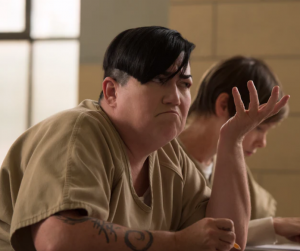
 ‘Chest binding’, the action of wrapping ones breasts up so tightly that they become less visible, is popular among trans and non-binary-identified girls.
‘Chest binding’, the action of wrapping ones breasts up so tightly that they become less visible, is popular among trans and non-binary-identified girls.
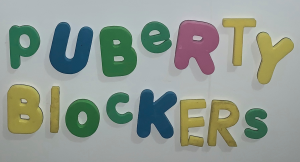 Dr Norman Spack, a paediatric endocrinologist at the Boston Children’s Hospital (USA), who treated Green’s child, has prescribed puberty blockers to ‘
Dr Norman Spack, a paediatric endocrinologist at the Boston Children’s Hospital (USA), who treated Green’s child, has prescribed puberty blockers to ‘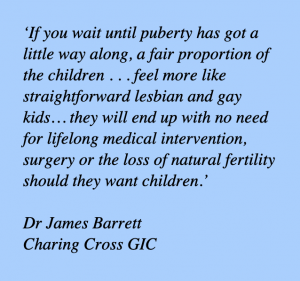 Currently around 40% of children seen by the GIDS service go on to take puberty blockers. These drugs are used ‘off label’ and have been
Currently around 40% of children seen by the GIDS service go on to take puberty blockers. These drugs are used ‘off label’ and have been  At the WPATH Symposium in Amsterdam in 2016, GIDS (UK)
At the WPATH Symposium in Amsterdam in 2016, GIDS (UK) 